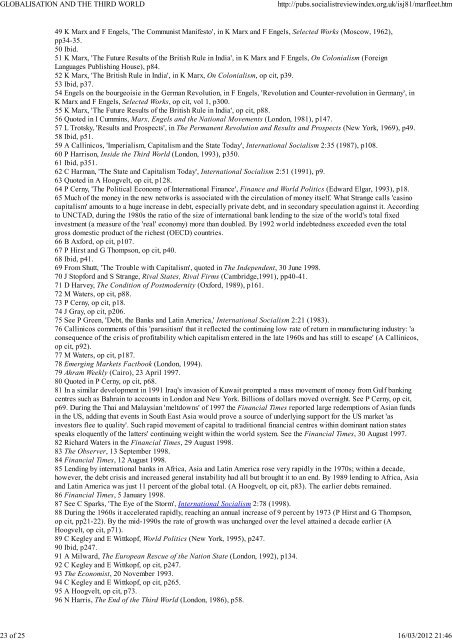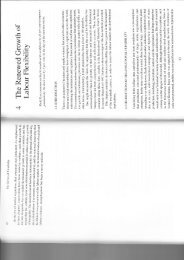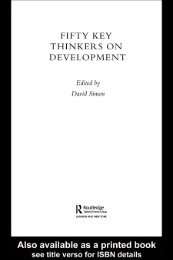GLOBALISATION AND THE THIRD WORLD.pdf - Steerweb.org
GLOBALISATION AND THE THIRD WORLD.pdf - Steerweb.org
GLOBALISATION AND THE THIRD WORLD.pdf - Steerweb.org
You also want an ePaper? Increase the reach of your titles
YUMPU automatically turns print PDFs into web optimized ePapers that Google loves.
<strong>GLOBALISATION</strong> <strong>AND</strong> <strong>THE</strong> <strong>THIRD</strong> <strong>WORLD</strong>http://pubs.socialistreviewindex.<strong>org</strong>.uk/isj81/marfleet.htm23 of 25 16/03/2012 21:4649 K Marx and F Engels, 'The Communist Manifesto', in K Marx and F Engels, Selected Works (Moscow, 1962),pp34-35.50 Ibid.51 K Marx, 'The Future Results of the British Rule in India', in K Marx and F Engels, On Colonialism (ForeignLanguages Publishing House), p84.52 K Marx, 'The British Rule in India', in K Marx, On Colonialism, op cit, p39.53 Ibid, p37.54 Engels on the bourgeoisie in the German Revolution, in F Engels, 'Revolution and Counter-revolution in Germany', inK Marx and F Engels, Selected Works, op cit, vol 1, p300.55 K Marx, 'The Future Results of the British Rule in India', op cit, p88.56 Quoted in I Cummins, Marx, Engels and the National Movements (London, 1981), p147.57 L Trotsky, 'Results and Prospects', in The Permanent Revolution and Results and Prospects (New York, 1969), p49.58 Ibid, p51.59 A Callinicos, 'Imperialism, Capitalism and the State Today', International Socialism 2:35 (1987), p108.60 P Harrison, Inside the Third World (London, 1993), p350.61 Ibid, p351.62 C Harman, 'The State and Capitalism Today', International Socialism 2:51 (1991), p9.63 Quoted in A Hoogvelt, op cit, p128.64 P Cerny, 'The Political Economy of International Finance', Finance and World Politics (Edward Elgar, 1993), p18.65 Much of the money in the new networks is associated with the circulation of money itself. What Strange calls 'casinocapitalism' amounts to a huge increase in debt, especially private debt, and in secondary speculation against it. Accordingto UNCTAD, during the 1980s the ratio of the size of international bank lending to the size of the world's total fixedinvestment (a measure of the 'real' economy) more than doubled. By 1992 world indebtedness exceeded even the totalgross domestic product of the richest (OECD) countries.66 B Axford, op cit, p107.67 P Hirst and G Thompson, op cit, p40.68 Ibid, p41.69 From Shutt, 'The Trouble with Capitalism', quoted in The Independent, 30 June 1998.70 J Stopford and S Strange, Rival States, Rival Firms (Cambridge,1991), pp40-41.71 D Harvey, The Condition of Postmodernity (Oxford, 1989), p161.72 M Waters, op cit, p88.73 P Cerny, op cit, p18.74 J Gray, op cit, p206.75 See P Green, 'Debt, the Banks and Latin America,' International Socialism 2:21 (1983).76 Callinicos comments of this 'parasitism' that it reflected the continuing low rate of return in manufacturing industry: 'aconsequence of the crisis of profitability which capitalism entered in the late 1960s and has still to escape' (A Callinicos,op cit, p92).77 M Waters, op cit, p187.78 Emerging Markets Factbook (London, 1994).79 Ahram Weekly (Cairo), 23 April 1997.80 Quoted in P Cerny, op cit, p68.81 In a similar development in 1991 Iraq's invasion of Kuwait prompted a mass movement of money from Gulf bankingcentres such as Bahrain to accounts in London and New York. Billions of dollars moved overnight. See P Cerny, op cit,p69. During the Thai and Malaysian 'meltdowns' of 1997 the Financial Times reported large redemptions of Asian fundsin the US, adding that events in South East Asia would prove a source of underlying support for the US market 'asinvestors flee to quality'. Such rapid movement of capital to traditional financial centres within dominant nation statesspeaks eloquently of the latters' continuing weight within the world system. See the Financial Times, 30 August 1997.82 Richard Waters in the Financial Times, 29 August 1998.83 The Observer, 13 September 1998.84 Financial Times, 12 August 1998.85 Lending by international banks in Africa, Asia and Latin America rose very rapidly in the 1970s; within a decade,however, the debt crisis and increased general instability had all but brought it to an end. By 1989 lending to Africa, Asiaand Latin America was just 11 percent of the global total. (A Hoogvelt, op cit, p83). The earlier debts remained.86 Financial Times, 5 January 1998.87 See C Sparks, 'The Eye of the Storm', International Socialism 2:78 (1998).88 During the 1960s it accelerated rapidly, reaching an annual increase of 9 percent by 1973 (P Hirst and G Thompson,op cit, pp21-22). By the mid-1990s the rate of growth was unchanged over the level attained a decade earlier (AHoogvelt, op cit, p71).89 C Kegley and E Wittkopf, World Politics (New York, 1995), p247.90 Ibid, p247.91 A Milward, The European Rescue of the Nation State (London, 1992), p134.92 C Kegley and E Wittkopf, op cit, p247.93 The Economist, 20 November 1993.94 C Kegley and E Wittkopf, op cit, p265.95 A Hoogvelt, op cit, p73.96 N Harris, The End of the Third World (London, 1986), p58.




